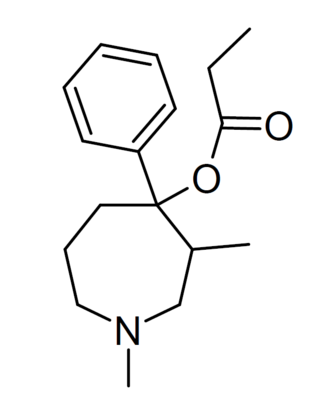
Dextrorphan (DXO) is a psychoactive drug of the morphinan class which acts as an antitussive or cough suppressant and dissociative hallucinogen. It is the dextrorotatory enantiomer of racemorphan; the levorotatory enantiomer is levorphanol. Dextrorphan is produced by O-demethylation of dextromethorphan by CYP2D6. Dextrorphan is an NMDA antagonist and contributes to the psychoactive effects of dextromethorphan.

Levorphanol is an opioid medication used to treat moderate to severe pain. It is the levorotatory enantiomer of the compound racemorphan. Its dextrorotatory counterpart is dextrorphan.

Levomethorphan (LVM) (INN, BAN) is an opioid analgesic of the morphinan family that has never been marketed. It is the L-stereoisomer of racemethorphan (methorphan). The effects of the two isomers of racemethorphan are quite different, with dextromethorphan (DXM) being an antitussive at low doses and a dissociative hallucinogen at much higher doses. Levomethorphan is about five times stronger than morphine.

Methorphan comes in two isomeric forms, each with differing pharmacology and effects:

Acetyldihydrocodeine is an opiate derivative discovered in Germany in 1914 and was used as a cough suppressant and analgesic. It is not commonly used, but has activity similar to other opiates. Acetyldihydrocodeine is a very close relative derivative of thebacon, where only the 6-7 bond is unsaturated. Acetyldihydrocodeine can be described as the 6-acetyl derivative of dihydrocodeine and is metabolised in the liver by demethylation and deacetylation to produce dihydromorphine.

Properidine is an opioid, an analgesic, and the isopropyl analog of pethidine. Properidine is under international control and is listed in the United States under the Controlled Substances Act (1970) as a Schedule I substance. It is a narcotic, with an Administrative Controlled Substances Code Number (ACSCN) of 9644 and a 2 gramme annual aggregate manufacturing quota as of 2014. The salt in use is hydrochloride, with a free base conversion ratio of 0.88.

Benzylmorphine (Peronine) is a semi-synthetic opioid narcotic introduced to the international market in 1896 and that of the United States very shortly thereafter. It is much like codeine, containing a benzyl group attached to the morphine molecule just as the methyl group creates codeine and the ethyl group creates ethylmorphine or dionine. It is about 90% as strong as codeine by weight.

Hydroxypethidine (Bemidone) is an opioid analgesic that is an analogue of the more commonly used pethidine (meperidine). Hydroxypethidine is slightly more potent than meperidine as an analgesic, 1.5x meperidine in potency, and it also has NMDA antagonist properties like its close relative ketobemidone.

Normethadone, also known as desmethylmethadone or phenyldimazone, is a synthetic opioid analgesic and antitussive agent. Normethadone is listed under the Single Convention on Narcotic Drugs 1961 and is a Schedule I Narcotic controlled substance in the United States, with a DEA ACSCN of 9635 and an annual manufacturing quota of 2 grams. It has an effective span of action for about 14 days, and is 12 to 20 times stronger than morphine. The salts in use are the hydrobromide, hydrochloride (0.890), methyliodide (0.675), oxalate (0.766), picrate (0.563), and the 2,6-ditertbutylnapthalindisulphonate (0.480).

Phenomorphan is an opioid analgesic. It is not currently used in medicine, but has similar side-effects to other opiates, which include itching, nausea and respiratory depression.

Proheptazine is an opioid analgesic related to pethidine. It was invented in the 1960s.

Benzethidine is a 4-phenylpiperidine derivative that is related to the clinically used opioid analgesic drug pethidine.

Levophenacylmorphan is a morphinan derivative that acts as an opioid agonist. It has potent analgesic effects and is around 10x more potent than morphine. Adverse effects associated with its use are those of the opioids as a whole, including pruritus, nausea, respiratory depression, euphoria and development of tolerance and dependence to its effects.

Hydromorphinol, is an opiate analogue that is a derivative of morphine, where the 14-position has been hydroxylated and the 7,8- double bond saturated. It has similar effects to morphine such as sedation, analgesia and respiratory depression, but is twice as potent as morphine and has a steeper dose-response curve and longer half-life. It is used in medicine as the bitartrate salt and hydrochloride

Norcodeine is an opiate analogue that is the N-demethylated derivative of codeine. It has relatively little opioid activity in its own right, but is formed as a metabolite of codeine following ingestion.

Methyldesorphine is an opioid analgesic. First synthesized in Germany in 1940 and patented in the US in 1952, it has a high potential for abuse as with any potent opioid agonist, and is sometimes found along with desomorphine as a component of the home-made opioid mixture known as "Krokodil" used in Russia and the neighboring former Soviet republics. It is approximately 15 times more potent than morphine as an analgesic but if the 6-7 bond is saturated, the β isomer is some 50 times more potent than morphine.

Racemoramide, or simply moramide, is an opioid analgesic and a racemic mixture of the substances dextromoramide and levomoramide, two enantiomers of a chiral molecule.

Norlevorphanol is an opioid analgesic of the morphinan family that was never marketed. It is the levo-isomer of 3-hydroxymorphinan (morphinan-3-ol). Norlevorphanol is a Schedule I Narcotic controlled substance in the United States with an ACSCN of 9634 and in 2014 it had an annual aggregate manufacturing quota of 52 grams. It is used as the hydrobromide and hydrochloride (0.870).

Isomethadone (INN, BAN; trade name Liden; also known as isoamidone) is a synthetic opioid analgesic and antitussive related to methadone that was used formerly as a pharmaceutical drug but is now no longer marketed. Isomethadone was used as both an analgesic and antitussive. It binds to and activates both the μ- and δ-opioid receptors, with the (S)-isomer being the more potent of the two enantiomers. Isomethadone is a Schedule II controlled substance in the United States, with an ACSCN of 9226 and a 2014 aggregate manufacturing quota of 5 g. The salts in use are the hydrobromide (HBr, free base conversion ratio 0.793), hydrochloride (HCl, 0.894), and HCl monohydrate (0.850). Isomethadone is also regulated internationally as a Schedule I controlled substance under the United Nations Single Convention on Narcotic Drugs of 1961.

Norpipanone is an opioid analgesic related to methadone which was developed in Germany and distributed in Hungary, Argentina, and other countries. It had originally not been under international control but upon observation of case reports of addiction it was reviewed and shortly thereafter became a controlled substance. In the United States, it is a Schedule I controlled substance. The salts in use are the hydrobromide and hydrochloride (0.902).



















